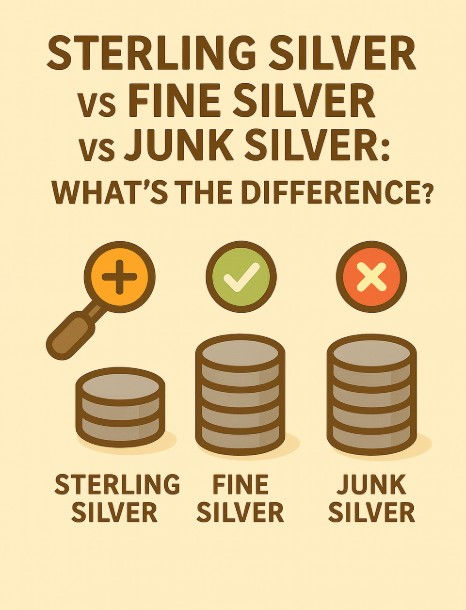Metal Purity Explained: Understanding Gold Karats, Silver Grades, and Platinum/Palladium Standards
- GoldsilverJapan

- Aug 24
- 5 min read
Whether you're stacking bullion, buying collectible coins, or investing for the long term, metal purity is one of the most important—and often misunderstood—concepts in the world of precious metals. In this guide, we’ll break down what purity means, explain karat vs. fineness, compare the different standards across gold, silver, platinum, and palladium, and offer real-world examples of coins and bars that match each category.
We’ll also answer common questions like:
“Is 24K gold better than 22K?”
“Why is platinum only .9995 instead of .9999?”
“What is the best purity for investing?”
“Are proof and semi-numismatic coins worth the premium?”
Let’s dive in.
🔍 What Does Metal Purity Mean?
Purity refers to how much of a specific precious metal (like gold or silver) is present in a coin, bar, or piece of jewelry. It is typically expressed in two formats:
Karat (K) – Used mostly for gold, measured out of 24.
Fineness – A decimal (e.g., .999) representing the percentage of the metal.
💡 Conversion Table:
Karat (Gold) | Purity (%) | Fineness |
24K | 99.99% | .9999 |
22K | 91.67% | .9167 |
18K | 75.00% | .750 |
14K | 58.33% | .5833 |
10K | 41.67% | .4167 |
🟡 GOLD: Understanding Karat Grades with Coin Examples
Gold purity plays a huge role in how coins behave in the market—especially when it comes to stacking, reselling, or collecting. Here are the major grades of gold used in coins:
✅ 24K Gold – Pure Gold (.9999 or .999)
Highly sought after by stackers and investors for its high metal content and simplicity.
Very soft and malleable, so less durable than lower-karat gold.
Often used in government-issued bullion coins.
🔹 Examples:
Canadian Gold Maple Leaf (.9999)
Austrian Philharmonic (.9999)
Royal Mint Britannia (post-2013)
Australian Kangaroo/Nugget (.9999)
💡 These are ideal for precious metals investors and widely recognized globally.
✅ 22K Gold – 91.67% Pure Gold
Mixed with copper or silver for added strength.
Slightly more durable than 24K, while still containing a full troy ounce of gold in most bullion coins.
🔹 Examples:
American Gold Eagle (.9167)
South African Krugerrand (.9167)
British Gold Sovereign (.9167)
🧠 These are great for those who want to stack gold but also want the coin to withstand handling.
✅ 18K Gold – 75% Pure Gold
Common in jewelry and some commemorative medals.
Rare in bullion investing due to the lower gold content.
🔹 Examples:
Some private mint medallions or souvenir coins.
⚠️ Not recommended for long-term stacking or investment purposes due to lower resale value and unclear market recognition.
❌ 14K / 10K Gold – Decorative Use
Not suitable for investing.
Primarily found in rings, watches, and accessories.
Very little actual gold content.
🛑 These grades fall outside standard bullion purity and should only be purchased for ornamental purposes.
⚪ SILVER: Purity Grades and What They Mean
Unlike gold, silver doesn’t use karats. Instead, it is almost always measured in fineness.
✅ .999 Fine Silver – Investment Grade
Also known as three nines fine.
Common in bullion coins, bars, and rounds.
🔹 Examples:
American Silver Eagle (.999)
Canadian Silver Maple Leaf (.9999)
Austrian Silver Philharmonic (.999)
Generic silver bars/rounds from private mints
💡 These are best for stacking and investing due to their high liquidity and global recognition.
✅ Sterling Silver – 92.5% Silver / .925 Fineness
Standard in jewelry, flatware, and older coins.
Less common in modern investment bullion.
🔹 Examples:
British Pre-1920 coins
U.S. commemorative coin programs (select issues)
Collectible bars and art rounds
⚠️ Not ideal for investors due to alloy content and lower purity.
✅ Other Silver Purities
.900 (90%) – Common in U.S. pre-1965 “junk silver” coins
.800 or lower – Found in older world coins and less desirable for bullion investors
📉 The lower the purity, the more difficult the resale.
🔵 PLATINUM & ⚫ PALLADIUM: Why They’re Usually .9995, Not .9999
🔍 Why Aren’t They “Four Nines Fine”?
Both platinum and palladium typically come with .9995 purity, which equals 99.95%. That’s slightly lower than the .9999 standard for gold, and here’s why:
High Melting Points – Platinum and palladium are extremely difficult to refine past 99.95%. The energy and equipment needed make higher purity costly.
Industrial Use – These metals are used heavily in automotive, electronics, and chemical industries. The .9995 level is sufficient for most applications.
Cost Efficiency – Refining from .9995 to .9999 doesn't yield significant practical benefits but does increase cost.
✅ Examples of Platinum Coins:
American Platinum Eagle (.9995)
Canadian Platinum Maple Leaf (.9995)
Australian Platinum Koala (.9995)
✅ Examples of Palladium Coins:
Canadian Palladium Maple Leaf (.9995)
American Palladium Eagle (.9995)
⚠️ You won’t find “.9999” platinum or palladium coins unless they’re made for marketing or niche appeal. And even then—they’re extremely rare.
🧠 Know Your Purpose: Investor, Collector, or Both?
Before buying anything, ask: Am I stacking or collecting?
Stackers should focus on high-purity bullion (.999+), low premiums, and recognizable government-issued coins or bars.
Collectors (Numismatists) may accept lower purity if the coin has historical significance or rarity.
Hybrid buyers (e.g., semi-numismatic collectors) must be cautious—sometimes you pay too much for too little return.
❌ Common Pitfalls: What to Avoid Based on Your Goals
🚫 Overpaying for Semi-Numismatics
Disney, Star Wars, James Bond, Marvel Coins...These limited edition coins often:
Carry huge premiums (30–100% over spot!)
Lose value quickly after launch
Are difficult to resell at a fair price
💡 Unless you're collecting for fun, these are not good for long-term stacking.
🚫 Confusing Proof Coins with Investment Coins
Proof coins have:
Mirror-like finishes
High attention to detail
Very high premiums
But:
They don’t perform better in value appreciation
They are not ideal for stacking or hedging against inflation
💰 How to Mitigate Premium Costs: Buy Bigger Weights
Premiums are the extra cost you pay above the spot price of the metal. The smaller the unit, the more premium you pay.
🧪 Example:
1 oz silver coin: ~$5–$8 premium per coin
100 oz silver bar: ~$1–$2 premium per oz
📉 While larger weights reduce premiums, they also reduce liquidity.You can’t sell off “half” a 100 oz bar easily, and buyers for larger units are more niche.
🔁 Balance your stack with a mix of small and large units to stay flexible.
🤔 FAQ: Most Asked Questions on Metal Purity
Q1: Is 24K gold better than 22K?
Yes, in terms of purity. But 22K is more durable and still contains a full ounce of gold in investment coins like the Gold Eagle.
Q2: Is .9999 silver better than .999?
Not really. The difference is negligible in practice. Both are investment-grade bullion.
Q3: Why are platinum and palladium usually .9995?
Because of industrial refining standards and difficulty achieving higher purities economically.
Q4: Is Sterling Silver (.925) good for stacking?
No. It's better suited for jewelry or collectibles. Stick with .999 for investing.
Q5: Should I care about purity if I’m just stacking for weight?
Yes. Higher purity means better liquidity, trust, and easier resale globally.
🏁 Final Thoughts: Match Purity with Purpose
Whether you're investing for the long haul, preparing for uncertain economic times, or building a beautiful coin collection—metal purity matters.
✔️ If you’re a stacker, go for:
.999 or .9999 bullion
Recognizable coins like Eagles, Maples, Britannias
Minimize premiums by buying larger units when possible
✔️ If you’re a collector, allow for lower purities:
.900 pre-1933 gold
.925 Sterling commemoratives
Semi-numismatics (with awareness of value)
But always remember: clarify your goals upfront. Whether it’s security, liquidity, or aesthetics—you’ll make better buying decisions when you know what you’re really after.











Comments